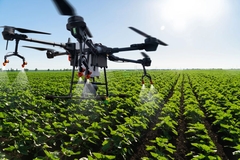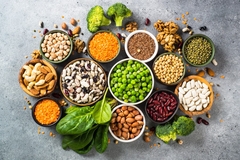SuperGround’s processing method tackles overfishing by utilizing fish bones and scales
15 Feb 2023 --- Finnish food tech company SuperGround is using the bones, scales and other hard tissue of fish to make the fish industry more efficient and environmentally sustainable by helping to reduce overfishing. Marketed as a “one-of-a-kind food production solution,” it is estimated that around 20% to 60% more food can be produced from fish than previously possible, with improved vitamin and calcium content.
Last year, the company launched a unique food production technology that enabled them to be the first to solve how the food industry can utilize chicken bones and their nutritional benefits in an unnoticeable way when producing poultry-based foods.
Now, the company has done the same for fish. For the first time, everything except the guts can be used in producing consumer-familiar fish products.

The outcome is fish mass that can be used in various ways. Around 15% to 30% of the mass made from bones and other hard tissues can be added when, for example, manufacturing fish balls without affecting their taste.
Similarly, up to 15% of the mass can be added or needled into fish fillet products such as fish sticks. The mass can also be used as broth or sauce. The mass enhances the taste and smooth mouth feeling of fish products.
Underutilization of the entire fish
Due to two reasons, the nutritional potential of fish has not been truly unlocked previously. First of all, an efficient process to soften hard tissues was nonexistent. Furthermore, only SuperGround’s heat treatment process, lasting around one minute, allows the preservation of precious vitamins and nutrients.
 SuperGround’s food production solution now enables using these previously unused hard tissues as the sole raw material in food production.Speaking with FoodIngredientsFirst, Santtu Vekkeli, founder and chief innovator at SuperGround, says the underutilization of bones as food has been on the list of unsolved challenges for years.
SuperGround’s food production solution now enables using these previously unused hard tissues as the sole raw material in food production.Speaking with FoodIngredientsFirst, Santtu Vekkeli, founder and chief innovator at SuperGround, says the underutilization of bones as food has been on the list of unsolved challenges for years.
“Hard tissues are mostly used as food inefficiently by cooking bone broths. Some small fish are eaten with bones, but for instance, salmon bones and heads are rarely eaten.”
“All machinery needed for good-tasting and nutritious hard tissue products are already in use by the F&B industry. These already existing machines just needed to be modified and integrated to work as one efficient system,” Vekkeli explains.
He invested his time and made very small-scale prototypes which allowed him to make smooth textured and good-tasting products from the hard tissues of practically any animal.
Technical advantages of fish vs. chicken
Vekkeli believes the method is “very suitable for fish, and there are some clear technical advantages when compared to chicken,” he underscores.
“Fish can even be considered the perfect material for the process. SuperGround’s method works with the hard tissues of fish with optimal efficiency as they are relatively soft and have a lot of protein. This allows the process to be run very efficiently and fast. Also, SuperGround mass made from hard fish tissues has an excellent ‘fish broth’ taste,” he continues, “and use of the mass is easy in multiple different food products.”
The main challenge is obtaining an off-color of the mass made from white flesh fish. This requires avoiding some storage processes in special cases, Vekkeli adds.
When asked what this could mean for fish manufacturers, he says the method allows them to “produce more products from the same amount of fish.”
“The SuperGround process allows manufacturers to also utilize the hard tissues of the fish in high-value products instead of discarding or as raw material for feed or biofuels.” According to SuperGround, this is essential for many manufacturers without the possibility of profitably using hard tissues, such as heads of fish.
The number of these unused parts is exceptionally high with smaller fish species, such as perch.
Adding the SuperGround paste is not “continuing the product by diluting its nutritional value,” but improving it, says Vekkeli. “At the same time, the mass has an excellent taste profile, and it can be used in the product without changing it or even used to improve its sensory and nutritional properties.”
Fish for nutrition
Fish bones and hard tissues have good nutritional profiles, and they differ from the flesh of the fish. A mixture of these all gives more diverse nutritional values for fish-based foods.
“For example, salmon heads have approximately 15% protein (mostly collagen) and 15% fats, and salmon skin is a good source of omega 3 fatty acids, vitamins B and D, and minerals like niacin.”
When asked about fish eyes, Vekkeli says: “Unfortunately, we do not have specific nutritional analysis data from the eyes, but they are included in the salmon head analysis.”
He adds that different fish species and hard tissues have significantly different nutritional values.
The process allows the use of the whole fish without the guts as food. Bone content can be very high or low, as in heads or cuts with a lot of muscle.
“We have found the method very versatile and have multiple new applications planned for the future,” continues Vekkeli. “There is much more to be done to enable the utilization of edible and nutritious raw materials that would normally be discarded or used for biofuel and feed production.”
Long-term ambitions
SuperGround wants to encourage and enable companies to utilize the full potential of fish. The company believes that with its new processing solutions, the fish industry can “simultaneously improve its efficiency and sustainability, while consumers see the fish products they know and love becoming more nutritious, tasty and sustainable.”
“This way, customers can make more sustainable choices without changing their dietary habits,” Vekkeli asserts.  It is estimated that around 20% to 60% more food can be produced this way from fish than previously possible.
It is estimated that around 20% to 60% more food can be produced this way from fish than previously possible.
Moreover, unlocking the full potential of fish improves the efficiency and sustainability of the fish industry SuperGround’s food processing technology and solution help increase both the efficiency and sustainability of fish food production. SuperGround wants to make the whole fish industry more sustainable with its technology by reducing environmental impacts, such as emissions and food waste.
With an estimated annual revenue of US$611.80 billion in 2023, the fish and seafood industry is expected to grow by 6.23% annually from 2023 to 2027.
Overcoming overfishing
At the same time, overfishing remains a significant challenge. According to the Food and Agriculture Organization of the United Nations, around a third of global stocks are overfished, threatening biodiversity and throwing ecosystems out of balance.
SuperGroud’s process allows larger amounts of total production from the same food material, and thus, for example, up to 60% more perch products can be made from the same quantity of fish caught.
The method allows using all the fish, except the guts, as food instead of discarding parts or producing feed or biofuels. Utilization of the method enables the production of the same amount of fish products from a lesser amount of caught fish without altering the sensory or nutritional properties of the product.
“In addition to plant-based alternatives, we need ready-to-use solutions that improve the sustainability of existing and popular food choices. And this is where we can contribute, simply because with our food production technology, more tasty fish products can be produced without increasing the use of fish and fishing altogether,” Vekkeli explains.
“Not using the full potential of fish in food production is a huge opportunity wasted – from the planet, sustainability, business and taste possibilities aspects,” he concludes.
By Elizabeth Green













